
A temple is a building reserved for spiritual rituals and activities such as prayer and sacrifice. Religions which erect temples include Christianity, Hinduism, Buddhism, Sikhism, Jainism, Islam, Judaism, Zoroastrianism, the Baha'i Faith, Taoism, Shinto, Confucianism, and ancient religions such as the Ancient Egyptian religion and the Ancient Greek religion.

The Community of Christ, known from 1872 to 2001 as the Reorganized Church of Jesus Christ of Latter Day Saints (RLDS), is an American-based international church, and is the second-largest denomination in the Latter Day Saint movement. The church reports 250,000 members in 1,100 congregations in 59 countries. The church traces its origins to Joseph Smith's establishment of the Church of Christ on April 6, 1830. His eldest son Joseph Smith III formally accepted leadership of the church on April 6, 1860 in the aftermath of the 1844 death of Joseph Smith.
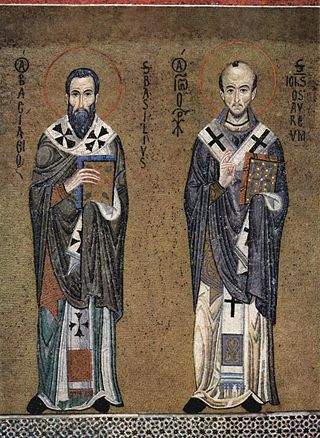
Divine Liturgy or Holy Liturgy is the Eucharistic service of the Byzantine Rite, a liturgical rite developed from the Antiochene Rite of Christian liturgy which is that of the Ecumenical Patriarchate of Constantinople. As such, it is used in the Eastern Orthodox, the Greek Catholic Churches, and the Ukrainian Lutheran Church. Although the same term is sometimes applied in English to the Eucharistic service of Armenian Christians, both of the Armenian Apostolic Church and of the Armenian Catholic Church, they use in their own language a term meaning "holy offering" or "holy sacrifice". Other churches also treat "Divine Liturgy" simply as one of many names that can be used, but it is not their normal term.
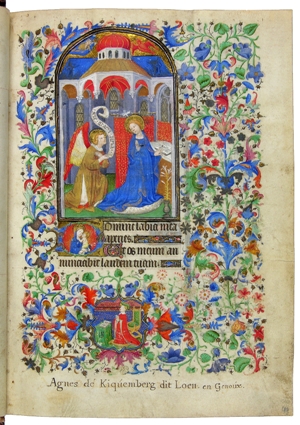
In the practice of Christianity, canonical hours mark the divisions of the day in terms of fixed times of prayer at regular intervals. A book of hours, chiefly a breviary, normally contains a version of, or selection from, such prayers.
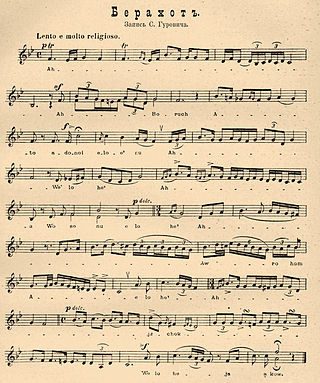
The Amidah, also called the Shemoneh Esreh, is the central prayer of the Jewish liturgy. Observant Jews recite the Amidah at each of three daily prayer services in a typical weekday: morning (Shacharit), afternoon (Mincha), and evening (Ma'ariv). On Shabbat, Rosh Chodesh, and Jewish festivals, a fourth Amidah (Mussaf) is recited after the morning Torah reading, and once per year a fifth Amidah (Ne'ilah) is recited, around sunset on Yom Kippur. Due to the importance of the Amidah, in rabbinic literature it is simply called "hatefila". According to legend, the prayer was composed by the Rabbis of the Anshei Knesset HaGedolah. Accordingly, in Judaism, to recite the Amidah is a mitzvah de-rabbanan, i.e., a commandment of rabbinic origin.
The Apostolic Christian Church (ACC) is a worldwide Christian denomination from the Anabaptist tradition that practices credobaptism, closed communion, greeting other believers with a holy kiss, a capella worship in some branches, and the headcovering of women during services. The Apostolic Christian Church only ordains men, who are authorized to administer baptism, the Lord's Supper, and the laying on of hands.

The Temple in Independence, Missouri, is a house of worship and education "dedicated to the pursuit of peace". It dominates the skyline of Independence and has become the focal point of the headquarters of the Community of Christ. The temple was built by the Community of Christ in response to a revelation presented at their 1984 World Conference by church prophet-president Wallace B. Smith. The revelation was the culmination of instructions shared over the course of more than 150 years by prior prophet-presidents recognized by the Community of Christ. Groundbreaking for the temple took place on April 6, 1990, and the completed structure was dedicated on April 17, 1994.
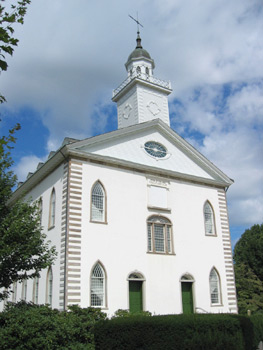
The Kirtland Temple is a temple of the Community of Christ, formerly the Reorganized Church of Jesus Christ of Latter Day Saints, located in Kirtland, Ohio, United States. It is the first temple built by adherents of the Latter Day Saint movement and was designed by Joseph Smith, the founder and original leader of the movement. The design mixes the Federal, Greek Revival, and Gothic Revival architectural styles. It has been a National Historic Landmark since 1969.

World Conference is the highest legislative body in Community of Christ and is empowered to act for the entire church. It operates according to a principle known as "common consent" and is presided over by the First Presidency. The functioning of the councils, quorums and orders of the church are also considered an important part of the World Conference.

In the Latter Day Saint movement, a temple is a building dedicated to be a house of God and is reserved for special forms of worship. A temple differs from a church meetinghouse, which is used for weekly worship services. Temples have been a significant part of the Latter Day Saint movement since early in its inception. Today, temples are operated by several Latter Day Saint denominations. The most prolific builder of temples of the Latter Day Saint movement is the Church of Jesus Christ of Latter-day Saints. The Church has 315 temples in various phases, which includes 178 dedicated temples, 58 currently under construction, and 79 others announced. Several others within the movement have built, or attempted to build, temples. The Community of Christ operates two temples in the United States, which are open to the public and are used for worship services, performances, and religious education. Other denominations with temples are the Apostolic United Brethren, the Church of Christ, the Fundamentalist Church of Jesus Christ of Latter-Day Saints and the Righteous Branch of the Church of Jesus Christ of Latter-day Saints.
The "Third Temple" refers to a hypothetical rebuilt Temple in Jerusalem. It would succeed Solomon's Temple and the Second Temple, the former having been destroyed during the Babylonian siege of Jerusalem in c. 587 BCE and the latter having been destroyed during the Roman siege of Jerusalem in 70 CE. Although it remains unbuilt, the notion of and desire for the Third Temple is sacred in Judaism, and particularly in Orthodox Judaism; it is anticipated as the most sacred place of worship for Jews. The Hebrew Bible holds that Jewish prophets called for its construction to be fulfilled prior to, or in tandem with, the Messianic Age. The building of the Third Temple also plays a major role in some interpretations of Christian eschatology.
Sext, or Sixth Hour, is a canonical hour of the Divine Office of almost all the traditional Christian liturgies. It consists mainly of psalms and is held around noon. Its name comes from Latin and refers to the sixth hour of the day after dawn. With Terce, None and Compline it belongs to the so-called "Little Hours".

The Alexandrian rites are a collection of ritual families and uses of Christian liturgy employed by three Oriental Orthodox churches, and by three Eastern Catholic Churches.
In the Catholic Church, liturgy is divine worship, the proclamation of the Gospel, and active charity. Catholic liturgies are broadly categorized as the Latin liturgical rites of the Latin Church and the Eastern Catholic liturgies of the Eastern Catholic Churches.

The history of Community of Christ, formerly known as the Reorganized Church of Jesus Christ of Latter Day Saints, covers a period of approximately 200 years. The church's early history traces to the "grove experience" of Joseph Smith, who prayed in the woods near his home in Palmyra, New York, in the early-19th century. Several accounts of this experience have surfaced over the years. Most of the accounts share a common narrative indicating that when he went to the woods to pray, he experienced a period of encountering evil or despair, but then experienced an epiphany or vision in which he came to know and understand God's goodness. Later, as an adult, Smith founded the Church of Christ on April 6, 1830.
In Christian liturgical worship, preces, also known in the Anglican prayer book tradition as the suffrages, are short petitions that are said or sung as versicles and responses by the officiant and congregation respectively. It is one of the oldest forms of prayer in Christianity, rooted in the pre-Christian Hebrew prayers of the Psalms used in Temple worship.

Church Women United (CWU) is a national ecumenical Christian women's movement representing Protestant, Roman Catholic, Orthodox and other Christian women. Founded in 1941, as the United Council of Church Women, this organization has more than 1,200 local and state units in the United States and Puerto Rico. CWU's members represent 26 supporting denominations and organizations. Offices are located in New York City, Washington DC and at the United Nations.

Prostration is the gesture of placing one's body in a reverentially or submissively prone position. Typically prostration is distinguished from the lesser acts of bowing or kneeling by involving a part of the body above the knee, especially the hands, touching the ground.
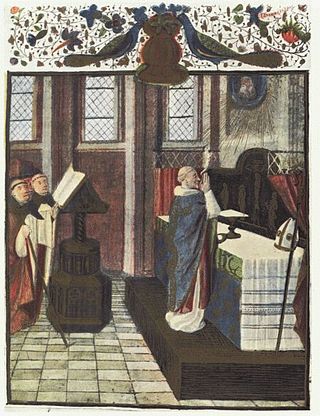
Ad orientem, meaning "to the east" in Ecclesiastical Latin, is a phrase used to describe the eastward orientation of Christian prayer and Christian worship, comprising the preposition ad (toward) and oriens, participle of orior.
The Daily Office in Anglican churches focuses the traditional canonical hours on daily services of Morning Prayer and Evening Prayer, usually following the Book of Common Prayer. As in other Christian traditions, either clergy or laity can lead the daily office. Most Anglican clergy are required to pray Morning and Evening Prayer daily.














